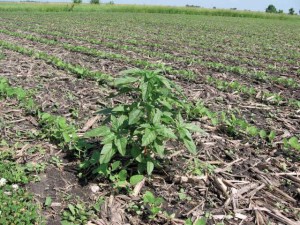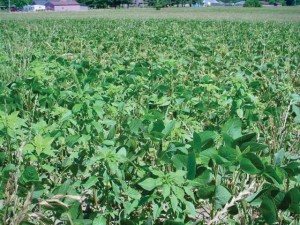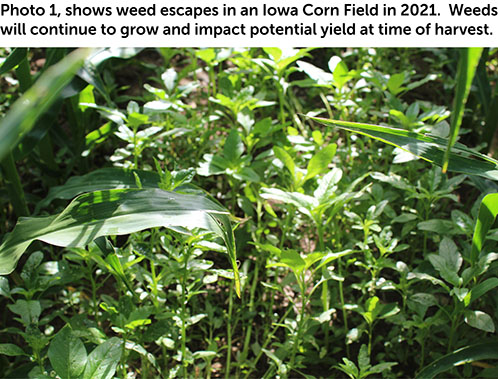The Weed Resistance Problem: A Matter Of Billions
To appreciate just how severe the herbicide-resistant weeds problem has become in the U.S., consider this statistic: According to researchers, approximately half of the country’s growers said that hard-to-kill weeds were a “major problem” in their crop fields during the 2013 growing season. In hard numbers, this translated into more than 70 million acres of land infested with herbicide-resistant weeds, a 17% increase from the previous year. Overall, weed scientists now say there are 200 species of weeds with confirmed resistance to one or more widely used herbicides.
According to Damon Palmer, U.S. commercial leader, Enlist, Dow AgroSciences, this uptick in infested acreage is all the more impressive when you consider that the weather conditions in 2013 didn’t necessarily favor weed growth as in prior years. “As you look across the country, there definitely hasn’t been a decrease in the number of acres being affected by herbicide-resistant weeds,” says Palmer. “With all the cooler and wetter conditions that much of the country experienced during 2013, they should have been a little easier to control than in the hotter weather years we’ve been having. But that wasn’t the case and their numbers still increased.”
The toll these herbicide-resistant weeds can have on growers is staggering. Some varieties can reach 8- to 10-feet in height, with strong stems that can damage farm equipment they encounter. Furthermore, some plants can produce hundreds of thousands of seeds, some of which can remain viable in soil for up to 50 years (as in the case of velvetleaf).
Even worse is the impact these weeds have on the crops themselves. According to a 2009-11 study conducted by the University of Minnesota Extension on corn, when a weed reaches a height of 3 to 4 inches (normally when corn is around the V3 to V4 growth stage), the crop loses approximately 12 to 13 bushels per acre within the first week. During the second week the weed is present, this loss increases to 27 to 29 bushels per acre. By their nature, weeds can exhibit a “luxury consumption” of certain crop inputs such as nitrogen. Furthermore, dense infestations of weeds can lead to allelopathy, a suppression of plant growth due to the release of natural-plant derived substances.
For growers, herbicide-resistant weeds have become a costly problem. At the very least, they are being forced to add additional herbicide applications to protect their investments. At worst, some are going back to hiring crews to hand weed their fields. In both cases, estimates University of Wisconsin researcher Vince Davis, this is adding approximately $2 billion to growers’ annual crop production bills.
And this isn’t the only time billions come up when discussing the impact of herbicide-resistant weeds. “Weed resistance is something we all have to deal with in agriculture,” says David Hollinrake, vice president, agricultural commercial operations marketing for Bayer CropScience. “Today, when you consider the losses in crop yields, weeds around the globe eat the food to feed about one billion people.”
How Resistance Starts
By their nature, many weeds have a natural ability to develop resistance. Recently, a computer model was developed by the University of Arkansas that analyzed the evolution of resistance to herbicides using the Mississippi Delta region of eastern Arkansas as its test case. Looking at 1,000 hypothetical rice fields, this model took into account three stages of growth for the crops and extended it over a 30-year period.
The findings from this computer model were eye-opening, to say the least. Based upon the model, if a certain herbicide is used alone in three annual applications, weed resistance can develop in as little as four years. More interestingly, the model showed that if a grower does not stop using a herbicide soon after resistance takes place, resistance can be accelerated for the next herbicide alternative used, even if it provides a different mode of action.

According to the latest data, glyphosate-resistant waterhemp has been confirmed in 12 states.
A similar study was conducted by the University of Missouri on one of the major Midwestern weeds to show resistance, waterhemp. According to the latest data, glyphosate-resistant waterhemp has been confirmed in 12 states. More telling, more than two-thirds of the waterhemp population sampled in the state of Missouri was found to be resistant to the popular herbicide.
For the study, the University of Missouri researchers collected waterhemp seed samples from 144 soybean fields in 54 Missouri counties during 2008 and 2009. Based upon their findings, 94% of the glyphosate-resistant waterhemp populations had three aspects in common:
■ Soybeans were the only crop planted in these fields in consecutive years.
■ Glyphosate was the only herbicide used in these fields for three or more years.
■ The fields contained waterhemp showing signs of having survived the previous herbicide application.
“It isn’t herbicides that create herbicide-resistant weeds,” says Dr. Bryan Young, a professor at Southern Illinois University. “Instead, the culprit is how we use herbicides in an overall weed management strategy. To preserve the effectiveness of herbicides, it is imperative that we become better stewards of their use. Minor changes made today can avoid costly problems in the future.”

A native to the southwestern U.S., Palmer amaranth first started showing signs of herbicide resistance in the late 1980s.
Further south, the problem child of herbicide-resistant weeds is Palmer amaranth (or pigweed, as it sometimes known). A native to the southwestern U.S., Palmer amaranth first started showing signs of herbicide resistance in the late 1980s. According to researchers, the weed showed confirmed resistance to glyphosate in 2006 in Macon County Georgia. Since then, glyphosate-resistant Palmer amaranth — which can produce more than 600,000 seeds per female plant — has spread across 13 states, including Texas, Virginia and Indiana.
Due to its rapid proliferation ability, the cost to control Palmer amaranth for growers has grown considerably over the past few years. In fact, for the cotton industry, herbicide costs for Palmer amaranth control have increased from $23 per acre in 2004 to $100 per acre in 2012.
“The current model simply isn’t sustainable,” says Dr. Stanley Culpepper, a professor in crop and soil science at the University of Georgia. “Growers have gone to war, and they are making progress from a weed management perspective, but not from an economic or environmental perspective. We need to figure out a way to get the same results far more cost-effectively and in a way that better protects our natural resources.”
The Race For Alternatives
Naturally, crop protection product suppliers have been working on the problem of herbicide-resistant weeds for years and several have potential solutions either just ready to enter the marketplace or coming out in time for the 2015 planting season.
For 2014, the options include Cobra from Valent U.S.A. Containing the active ingredient lactofen, Cobra can be used on such problem weeds as Palmer amaranth and waterhemp in soybeans.
Meanwhile, SePRO Corp. and Nichino America have partnered to launch Brake F2 for Palmer amaranth control in cotton. Containing the active ingredients fluridone and fomesafen, Brake 2F has been granted a Section 18 emergency exemption for 2014 in approved counties in Georgia, South Carolina, North Carolina and Tennessee. According to Dr. Tyler Koschnick, vice president of research and regulatory for SePRO, fomesafen requires low moisture for activation, but provides shorter residual control. Meanwhile, fluridone requires more moisture for activation, but has longer residual control. “The combination of the two complementary active ingredients has shown a tremendous advantage with crop safety with growers reporting extended control of up to six to 10 weeks or longer, depending upon soil type and conditions,” says Koschnick.
Then there’s Engenia, described as a “technologically advanced” dicamba formulation by developer BASF. Expected to have its commercial launch for soybeans in 2014, Engenia has demonstrated “effective control of key broadleaf weeds, including glyphosate-resistant Palmer amaranth, waterhemp, marestail and common/giant ragweed,” says Luke Bozeman, technical market manager, BASF.
In 2015, Dow AgroSciences expects to receive approval for its Enlist Weed Control system. A version of 2,4-D using the company’s Colex-D technology, Enlist has achieved greater than 95% control of several glyphosate-resistant weed types, according to Mike Peterson, global biology leader for the Enlist system at Dow. “Herbicides have been shown to be a key part of efficient, sustainable weed management systems that maximize production while preserving soil and water resources,” says Peterson. “It is important to note that herbicide-tolerant crops have enabled great advances in soil conservation and carbon sequestration. Having farmers go back to widespread tillage to control weeds will negate those environmental advances.”
Also expected to hit the market in 2015 is Acuron from Syngenta Crop Protection. Containing four active ingredients including bicyclopyrene, Acuron employs three modes of action to tackle more than 70 broadleaf weeds including Palmer amaranth and waterhemp, says Dr. Gordon Vail, technical product lead for herbicides at the company.
No matter what options are available in the future for combating herbicide-resistant weeds, the University of Wisconsin’s Davis says the more, the better. “Diversification is the most important thing farmers can do to manage these weeds,” he says. “This includes diversification of effective herbicide modes of action, diversified weed management practices and also utilizing non-herbicide control options such as judicious tillage, cleaning equipment of weed seed and diversified crop rotations. Weeds develop resistance more quickly when production systems remain static.”






